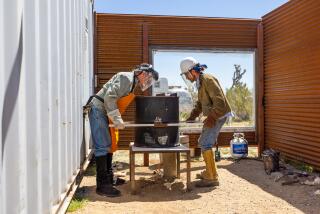World-Class Art From a Small Town in Oregon : Sculpture: Valley Bronze, a foundry that began as a hobby, has achieved international renown. Its success has revived a remote section of the Pacific Northwest.
- Share via
JOSEPH, Ore. — The local cowboys and loggers thought Glenn Anderson had a screw loose when he started Valley Bronze with a book on foundries and a half-dozen people casting statues in the corner of a logging truck repair shop.
Not anymore.
In just nine years, Valley Bronze, with 65 employees, has turned into one of the nation’s leading art foundries. It produces works large and small by world-class sculptors for millionaires’ mansions, corporate headquarters and Japanese golf courses. It also has revived the economy of this town of 1,100 people in the remote northeastern corner of Oregon.
Storefronts that were empty just a few years ago have reopened as art galleries and studios. Artists are moving in and driving up the real estate market. Three other foundries have spun off in the Wallowa Valley. The tourist season has expanded. Wallowa County is looking at zoning the first significant housing subdivision in Joseph’s history.
“And Valley Bronze has led it,” says Keith Lytle, president of the Bank of Wallowa County.
Artist David Manuel moved to town from Walla Walla, Wash., in 1980 to be closer to the land claimed as home by Chief Joseph, the Nez Perce leader who outwitted thS. Army in a dramatic dash for freedom in 1877 before he surrendered just miles short of the Canadian border. The town, a towering peak, and a creek are all named for him.
Manuel sold a set of three bronzes depicting Chief Joseph and two other Nez Perce leaders to Anderson, who was trying to retire after moving from La Pine, where he’d been in the real estate business. Anderson sold the bronzes for a nice profit.
The money from the bronzes went to start the foundry in 1982.
“I couldn’t take my work anywhere else and get the detail I get here, right down to the screws in the guns,” Manuel said. “Other artists knew if there was a foundry that could do my work and be able to satisfy me, they must be a damn good foundry. Pretty soon, I had to wait in line.”
The foundry got too big to be a hobby for Anderson. In 1988, he sold it to David Jackman, a lawyer who owned a cattle ranch in the north end of the county and had done some legal work for Valley Bronze. He brought in Lyle Isaak from Maiden Bronze outside Portland to be executive vice president.
“Hey, we’re not just a Northwest foundry. We’re world class,” says Isaak, gesturing around the Valley Bronze showroom in downtown Joseph. “Artists are seeking us out coast-to-coast and outside the United States.”
Valley Bronze was helped by Joseph’s location on the edge of the Eagle Cap Wilderness in the alpine splendor of the Wallowa Mountains, in a place known as America’s Switzerland.
“This kind of picturesque beauty and kind of untouched pristine environment is a real draw to the artists,” Isaak says. “Other artists want to be here because other artists are here.”
Lytle estimates that several hundred sculptors, painters and other artists now live in the county of just 6,950 people. They bring in a vital influx of cash at a time when the logging and cattle grazing that built Joseph are being curtailed by environmental constraints.
“Three years ago it looked like doomsville up here,” Manuel says. “The last couple of years real estate has escalated.”
Valley Bronze has found more success training local people to do the intricate work that transforms a clay sculpture into a monument of bronze, rather than bringing in experienced hands.
Dennis Brennan grew up on a local ranch owned by his grandfather, the late actor Walter Brennan, who also built the motel and opera house in town. He was getting a bad back bending over to shoe horses and now sits down as he applies the subtle patinas that bring a bronze to life.
“It pays better than cowboying,” Brennan says. “I’d rather put up with any artist than 20 below on a horse.”
Ramon Parmenter moved here from Eugene five years ago and now works in what used to be a grocery store. He produces graceful sculptures of dancers and athletes that command prices up to $300,000 each.
Parmenter’s sister-in-law and gallery director, Nancy Parmenter, likes being able to enjoy small-town comforts while still getting recognition in the art world.
“We can go back to New York now to an art expo and they say, ‘Oh, we know about Joseph,’ ” she said.
Isaak says the classic 19th-Century Western works of Frederick Remington and Charles Russell kept alive the idea of bronze sculpture in America, but now the medium is branching out and growing like never before.
“Monuments, large pieces, seem to be taking off not only in the United States, but also Japan, Europe, what I like to call the pleasure islands, like Hawaii, Tahiti--anywhere tourists are there seems to be a regeneration of monumental sculpture,” Isaak says.
More to Read
Sign up for Essential California
The most important California stories and recommendations in your inbox every morning.
You may occasionally receive promotional content from the Los Angeles Times.













